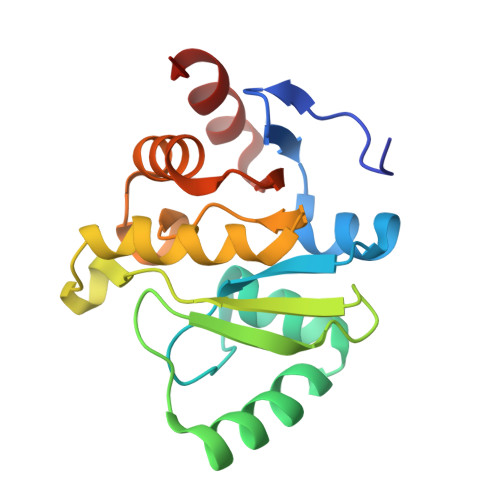Fragment binding to the Nsp3 macrodomain of SARS-CoV-2 identified through crystallographic screening and computational docking.
Schuller, M., Correy, G.J., Gahbauer, S., Fearon, D., Wu, T., Diaz, R.E., Young, I.D., Carvalho Martins, L., Smith, D.H., Schulze-Gahmen, U., Owens, T.W., Deshpande, I., Merz, G.E., Thwin, A.C., Biel, J.T., Peters, J.K., Moritz, M., Herrera, N., Kratochvil, H.T., Aimon, A., Bennett, J.M., Brandao Neto, J., Cohen, A.E., Dias, A., Douangamath, A., Dunnett, L., Fedorov, O., Ferla, M.P., Fuchs, M.R., Gorrie-Stone, T.J., Holton, J.M., Johnson, M.G., Krojer, T., Meigs, G., Powell, A.J., Rack, J.G.M., Rangel, V.L., Russi, S., Skyner, R.E., Smith, C.A., Soares, A.S., Wierman, J.L., Zhu, K., O'Brien, P., Jura, N., Ashworth, A., Irwin, J.J., Thompson, M.C., Gestwicki, J.E., von Delft, F., Shoichet, B.K., Fraser, J.S., Ahel, I.(2021) Sci Adv 7
- PubMed: 33853786
- DOI: https://doi.org/10.1126/sciadv.abf8711
- Primary Citation of Related Structures:
5RS7, 5RS8, 5RS9, 5RSB, 5RSC, 5RSD, 5RSE, 5RSF, 5RSG, 5RSH, 5RSI, 5RSJ, 5RSK, 5RSL, 5RSM, 5RSN, 5RSO, 5RSP, 5RSQ, 5RSR, 5RSS, 5RST, 5RSU, 5RSV, 5RSW, 5RSX, 5RSY, 5RSZ, 5RT0, 5RT1, 5RT2, 5RT3, 5RT4, 5RT5, 5RT6, 5RT7, 5RT8, 5RT9, 5RTA, 5RTB, 5RTC, 5RTD, 5RTE, 5RTF, 5RTG, 5RTH, 5RTI, 5RTJ, 5RTK, 5RTL - PubMed Abstract:
The severe acute respiratory syndrome coronavirus 2 (SARS-CoV-2) macrodomain within the nonstructural protein 3 counteracts host-mediated antiviral adenosine diphosphate-ribosylation signaling. This enzyme is a promising antiviral target because catalytic mutations render viruses nonpathogenic. Here, we report a massive crystallographic screening and computational docking effort, identifying new chemical matter primarily targeting the active site of the macrodomain. Crystallographic screening of 2533 diverse fragments resulted in 214 unique macrodomain-binders. An additional 60 molecules were selected from docking more than 20 million fragments, of which 20 were crystallographically confirmed. X-ray data collection to ultra-high resolution and at physiological temperature enabled assessment of the conformational heterogeneity around the active site. Several fragment hits were confirmed by solution binding using three biophysical techniques (differential scanning fluorimetry, homogeneous time-resolved fluorescence, and isothermal titration calorimetry). The 234 fragment structures explore a wide range of chemotypes and provide starting points for development of potent SARS-CoV-2 macrodomain inhibitors.
Organizational Affiliation:
Sir William Dunn School of Pathology, University of Oxford, South Parks Road, Oxford OX1 3RE, UK.















